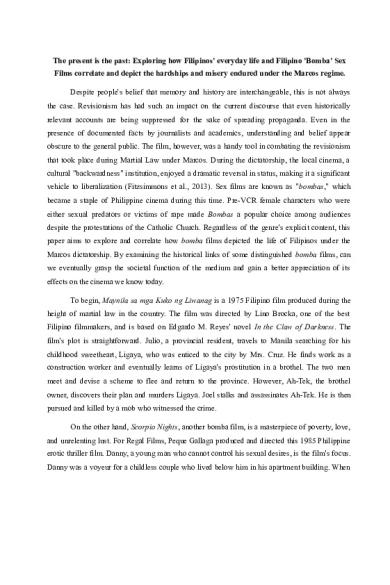The present is the past: Exploring how Filipinos\' everyday life and Filipino \'Bomba\' Sex Films correlate and depict the hardships and misery endured under the Marcos regime. PDF

| Title | The present is the past: Exploring how Filipinos\' everyday life and Filipino \'Bomba\' Sex Films correlate and depict the hardships and misery endured under the Marcos regime. |
|---|---|
| Author | Christine Talimongan |
| Course | Accountancy |
| Institution | Far Eastern University |
| Pages | 3 |
| File Size | 109.9 KB |
| File Type | |
| Total Downloads | 30 |
| Total Views | 120 |
Summary
For my Art Appreciation class...
Description
The present is the past: Exploring how Filipinos' everyday life and Filipino 'Bomba' Sex Films correlate and depict the hardships and misery endured under the Marcos regime. Despite people's belief that memory and history are interchangeable, this is not always the case. Revisionism has had such an impact on the current discourse that even historically relevant accounts are being suppressed for the sake of spreading propaganda. Even in the presence of documented facts by journalists and academics, understanding and belief appear obscure to the general public. The film, however, was a handy tool in combating the revisionism that took place during Martial Law under Marcos. During the dictatorship, the local cinema, a cultural "backwardness" institution, enjoyed a dramatic reversal in status, making it a significant vehicle to liberalization (Fitzsimmons et al., 2013). Sex films are known as " bombas," which became a staple of Philippine cinema during this time. Pre-VCR female characters who were either sexual predators or victims of rape made Bombas a popular choice among audiences despite the protestations of the Catholic Church. Regardless of the genre's explicit content, this paper aims to explore and correlate how bomba films depicted the life of Filipinos under the Marcos dictatorship. By examining the historical links of some distinguished bomba films, can we eventually grasp the societal function of the medium and gain a better appreciation of its effects on the cinema we know today. To begin, Maynila sa mga Kuko ng Liwanag is a 1975 Filipino film produced during the height of martial law in the country. The film was directed by Lino Brocka, one of the best Filipino filmmakers, and is based on Edgardo M. Reyes' novel In the Claw of Darkness. The film's plot is straightforward. Julio, a provincial resident, travels to Manila searching for his childhood sweetheart, Ligaya, who was enticed to the city by Mrs. Cruz. He finds work as a construction worker and eventually learns of Ligaya's prostitution in a brothel. The two men meet and devise a scheme to flee and return to the province. However, Ah-Tek, the brothel owner, discovers their plan and murders Ligaya. Joel stalks and assassinates Ah-Tek. He is then pursued and killed by a mob who witnessed the crime. On the other hand, Scorpio Nights, another bomba film, is a masterpiece of poverty, love, and unrelenting lust. For Regal Films, Peque Gallaga produced and directed this 1985 Philippine erotic thriller film. Danny, a young man who cannot control his sexual desires, is the film's focus. Danny was a voyeur for a childless couple who lived below him in his apartment building. When
he accidentally entered the couple's bedroom, the wife mistook him for her husband and consented to sex with him. The steamy affair had turned into an obsession, leading to the deaths of all the protagonists. The film's plot was based on a real-life story about a police officer who killed his wife after discovering she was having an affair with a college student living with them (Rio, 2018). Upon analyzing two films from the bomba genre, it is interesting that directors like Brocka and Gallaga drew inspiration from the period's use of symbolism. In Maynila sa mga Kuko ng Liwanag, Filipino Julio Madiaga is a typical middle-class man who has to rely on brute force to survive. The Inang Bayan, the Filipino concept of homeland, is Ligaya Paraiso. Atik, the Tagalog slang word for money, symbolizes corruption and greed (Cruz, 2017). As with Scorpio Nights, the information presented about these two people and the environment in which they live leaves us with no other interpretation of their prospects than bleakness and hopelessness (Baylon, 2014). Additionally, it emphasized a recurring theme during this time: police brutality and their unlawful actions while in authority. Under the guise of erotic thrillers, it both served as a commentary on Marcos' New Society and the oppressive policies of his regime. It also emphasized the painful realities of living below the average class during the Philippine Martial Law era, to the extent that people find other ways to pleasure themselves (Franco, 2021). In addition to the erotic content, bomba films share another characteristic. All of them feature scenes of political violence, some of which are pretty brutal. Films depicting dictatorship's brutality and drama allow viewers to empathize with those subjected to the horrors on screen, evoking a collective or individual sense of disgust and rage (Castillo, 2020). Even though bomba films were an essential tool for drawing attention to the issues of the day and the uncomfortable truths about society, they also served to perpetuate misogyny and the objectification of women in Filipino culture. The sexualization of women in the media is widely accepted; however, it does directly affect how society views women (Flores, 2019). Seeing as Filipino women are sexualized and objectified, they are often the victims of forced sex acts. By sexualizing women in the media creates a hypersexualized image of women that reinforces gender stereotypes and trivializes the subject of violence against women (Goud et al., 2020).
In conclusion, the two aforementioned movies and other ' bomba' sex films depict the hardships and misery endured by the Filipino people during the Marcos regime; however, they also evoke misogyny and over-sexualization in Filipino women. Through the realism depicted in the films, it contributed to the preservation of the Filipino national consciousness. Indeed, identity is shaped by history. By examining the bomba as a distinct genre with its historical context, we can develop a distinct, albeit multifaceted, Philippine cinema identity and national identity. Moreover, although there has been a decline in these types of films due to their explicit content, it is recommended that every Filipino be exposed to them, as there are still a significant number of people who are victims of misinformation denying the atrocities Martial Law. References: Baylon, R. (2014, February 5). Film Expression: Scorpio Nights (1985). Film Expression. http://filmexpression.blogspot.com/2014/02/scorpio-nights-1985.html Castillo, L. (2018). When watching films is resistance | IIAS. Www.iias.asia. https://www.iias.asia/the-newsletter/article/when-watching-films-resistance Cruz, E. S. (2017, September 23). Cinema on martial law. Philstar.com; The Philippine Star. https://www.philstar.com/opinion/2017/09/23/1742008/cinema-martial-law Fitzsimmons, L., & Lent, J. (2013). Popular Culture in Asia (p. 43). Palgrave Macmillan. Flores, Z. (2019). Sexualization and Objectification of Women in the Philippines. https://digitalcommons.tacoma.uw.edu/cgi/viewcontent.cgi? article=1037&context=gender_studies Rio, B. (2018, September 21). Watch these films if you want to understand Martial Law. Preen.ph. https://preen.ph/83353/watch-films-want-understand-martial-law Swift, J., & Gould, H. (2021, January 11). Not An Object: On Sexualization and Exploitation of Women and Girls. UNICEF USA. https://www.unicefusa.org/stories/not-objectsexualization-and-exploitation-women-and-girls/30366...
Similar Free PDFs

Ammianus and the Written Past
- 60 Pages

The Martian and the Car
- 2 Pages

The Parthenon and the Pantheon
- 4 Pages

The Mughals and the Rajputs
- 2 Pages
Popular Institutions
- Tinajero National High School - Annex
- Politeknik Caltex Riau
- Yokohama City University
- SGT University
- University of Al-Qadisiyah
- Divine Word College of Vigan
- Techniek College Rotterdam
- Universidade de Santiago
- Universiti Teknologi MARA Cawangan Johor Kampus Pasir Gudang
- Poltekkes Kemenkes Yogyakarta
- Baguio City National High School
- Colegio san marcos
- preparatoria uno
- Centro de Bachillerato Tecnológico Industrial y de Servicios No. 107
- Dalian Maritime University
- Quang Trung Secondary School
- Colegio Tecnológico en Informática
- Corporación Regional de Educación Superior
- Grupo CEDVA
- Dar Al Uloom University
- Centro de Estudios Preuniversitarios de la Universidad Nacional de Ingeniería
- 上智大学
- Aakash International School, Nuna Majara
- San Felipe Neri Catholic School
- Kang Chiao International School - New Taipei City
- Misamis Occidental National High School
- Institución Educativa Escuela Normal Juan Ladrilleros
- Kolehiyo ng Pantukan
- Batanes State College
- Instituto Continental
- Sekolah Menengah Kejuruan Kesehatan Kaltara (Tarakan)
- Colegio de La Inmaculada Concepcion - Cebu











